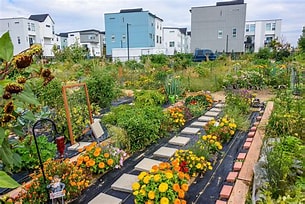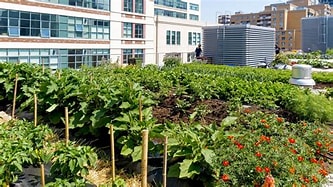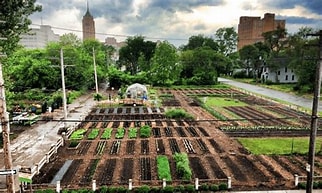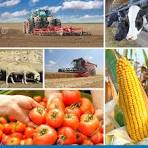The Rise of Agriculture in Urban Areas
Urban farming is not just a trend; it’s a movement that’s reshaping how we think about food production, community health, and sustainability. As cities grow and populations swell, the need for innovative solutions to food security has never been more pressing. This article will explore the rise of urban farming, its implications for food security, community health, and how it’s transforming our cities.
What is Urban Farming?
Urban farming, or urban agriculture, refers to the practice of cultivating, processing, and distributing food in or around urban areas. This can take many forms, from community gardens and rooftop farms to vertical farms and hydroponic systems. The idea is to bring food production closer to where people live, reducing the distance food travels from farm to table.

The Evolution of Urban Farming
Urban farming isn’t a new concept; it has roots that stretch back thousands of years. However, its resurgence in recent decades can be attributed to several factors: urbanization, the decline of agricultural land, and increasing awareness of food security issues. As cities expand, the demand for locally sourced food has surged, leading to innovative farming techniques that maximize limited space.
The Benefits of Urban Farming
Enhancing Food Security
One of the most significant benefits of urban farming is its potential to enhance food security. By growing food closer to urban populations, cities can reduce their reliance on long supply chains that are vulnerable to disruptions. This local production can help mitigate the impact of global crises such as pandemics or climate change.
Improving Community Health
Urban farming also plays a crucial role in improving community health. Access to fresh fruits and vegetables is vital for a balanced diet, yet many urban areas are classified as food deserts—places where residents have limited access to affordable and nutritious food. Urban farms can provide fresh produce directly to communities that need it most.
Promoting Sustainability
Sustainability is at the heart of urban farming practices. By utilizing methods such as hydroponics and vertical farming, urban farmers can produce food with less water and fewer pesticides than traditional farming methods. These practices not only conserve resources but also reduce carbon footprints associated with transporting food over long distances.
Types of Urban Farming

Urban farming encompasses a variety of methods and practices tailored to fit different environments. Here are some common types:
Community Gardens
Community gardens are shared spaces where residents can cultivate fruits, vegetables, and flowers. These gardens foster community spirit and provide an opportunity for neighbors to connect while promoting healthy eating habits.
Rooftop Gardens
Rooftop gardens utilize otherwise unused space atop buildings for growing crops. They provide numerous benefits such as improved air quality, reduced heat absorption in buildings, and enhanced aesthetics.
Vertical Farms
Vertical farming involves growing crops in stacked layers or on vertical surfaces. This method maximizes space usage and often employs technology such as LED lighting and climate control systems to optimize growth conditions.
Hydroponics and Aquaponics
Hydroponics is a method of growing plants in nutrient-rich water instead of soil. Aquaponics combines hydroponics with aquaculture (raising fish) in a symbiotic environment where fish waste provides nutrients for plants.
The Economic Impact of Urban Farming
Job Creation
Urban farming creates jobs not only in agriculture but also in related sectors such as food processing, distribution, and retail. As local farms expand, they require more hands on deck—from farmers to marketers—boosting employment opportunities within communities.
Supporting Local Economies
By sourcing food locally, urban farms keep money circulating within the community rather than sending it out to large agricultural corporations. This localized economy fosters resilience against economic downturns by creating self-sustaining communities.
Challenges Facing Urban Farmers
While urban farming presents numerous benefits, it also faces challenges that need addressing:
Limited Space
Space constraints are one of the most significant hurdles for urban farmers. Finding suitable land for cultivation can be difficult in densely populated areas where real estate prices are high.
Regulatory Barriers
Many cities have zoning laws that restrict agricultural activities within their limits. Navigating these regulations can be daunting for aspiring urban farmers who want to start their projects.
Access to Resources
Urban farmers often struggle with access to essential resources such as water, soil amendments, and funding for startup costs. Without proper support systems in place, many initiatives may falter before they even begin.
The Role of Technology in Urban Farming

Technology plays a pivotal role in the success of urban agriculture:
Smart Farming Techniques
The use of sensors and data analytics allows urban farmers to monitor crop conditions closely. By analyzing data on moisture levels, nutrient content, and temperature, farmers can make informed decisions that enhance yields.
Innovative Growing Systems
Hydroponics and aeroponics are revolutionizing how we grow food by minimizing resource use while maximizing output. These systems allow crops to grow without soil in controlled environments that optimize growth conditions.
Case Studies: Successful Urban Farming Initiatives
Gotham Greens: A Model for Urban Agriculture
Gotham Greens operates several rooftop greenhouses across major U.S. cities like New York City and Chicago. Their model demonstrates how urban farming can produce high yields while minimizing environmental impact through sustainable practices.
The Yisrael Family Urban Farm
Located in Sacramento’s South Oak Park neighborhood—a recognized food desert—this farm not only provides fresh produce but also serves as a community hub for education and engagement around healthy eating practices.
The Future of Urban Farming
As cities continue to expand and face challenges related to climate change and population growth, urban farming will become increasingly vital:
Policy Support for Urban Agriculture
Cities worldwide are recognizing the importance of supporting urban agriculture through policy initiatives that promote local food production. This includes providing grants for community gardens or easing zoning restrictions on agricultural activities.
Education and Awareness Programs
Educational programs aimed at teaching residents about sustainable practices will be crucial as more people become interested in growing their own food. Workshops on gardening techniques or cooking classes using fresh produce can empower communities.
A Must Read for All Poultry Farmers: A Poultry Nutrition Guide
Conclusion: A Sustainable Path Forward
Urban farming represents a transformative approach to addressing some of the most pressing challenges facing our cities today—from food insecurity to environmental sustainability. By fostering local production systems that prioritize health and well-being while promoting community engagement, we can create vibrant ecosystems that benefit everyone involved.
As we look ahead, it’s essential for policymakers, communities, and individuals alike to support this movement through education, funding opportunities, and collaborative efforts that ensure the success of urban farms everywhere. Together we can cultivate not just crops but also connections—nurturing healthier communities one garden at a time.
Meta Description
Discover how urban farming is reshaping cities by enhancing food security and community health through innovative practices like rooftop gardens and hydroponics.
FAQs About Urban Farming
1. What is urban farming?
Urban farming refers to cultivating crops within city limits using various methods like community gardens, rooftop farms, or vertical farms.
2. How does urban farming improve food security?
By producing food closer to consumers, urban farms reduce reliance on long supply chains vulnerable to disruptions while providing fresh produce directly to communities.
3. What are some common types of urban farming?
Common types include community gardens, rooftop gardens, vertical farms, hydroponics systems, and aquaponics setups.
4. What challenges do urban farmers face?
Challenges include limited space availability, regulatory barriers from zoning laws, access to resources like water or funding support.
5. How does technology influence urban farming?
Technology enhances efficiency through smart farming techniques like sensors for monitoring crop conditions and innovative systems like hydroponics that maximize yields with minimal resources.

